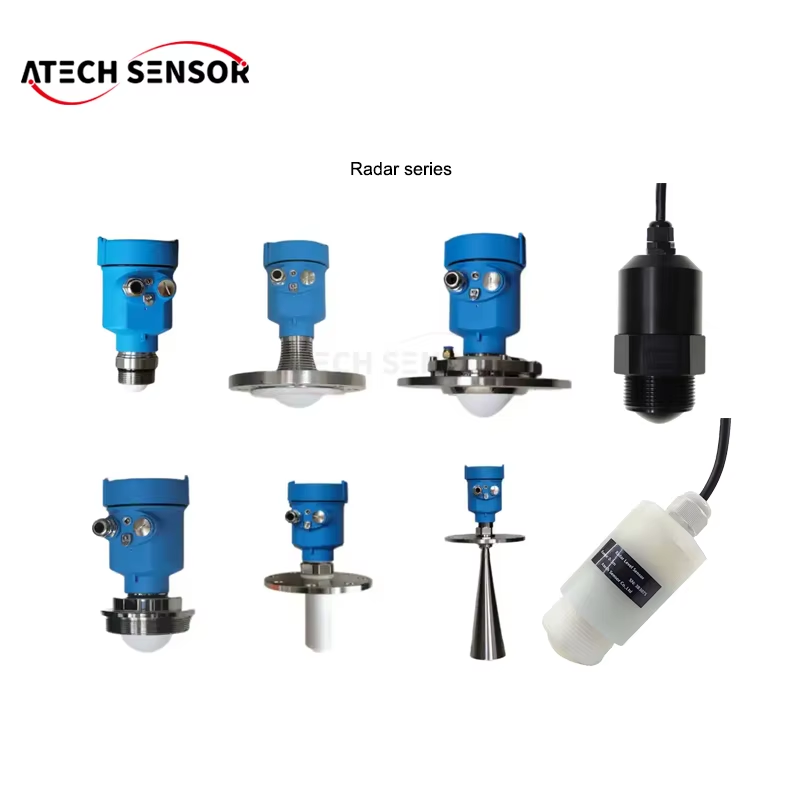Radar Level Meter Introduction
Radar level meter adopts the non-contact way to measure, is a high use rate of liquid level measurement instrument, by transmitting high-frequency electromagnetic wave and receiving the reflected back signal to measure the liquid level height.With accurate measurement, stable performance and other characteristics, suitable for a variety of liquid level measurement occasions, can measure the solid, liquid and gas and other forms of media.Radar level meter can be connected with computer system through a variety of interfaces to realize data acquisition and processing.
Working principle of radar level meter
Radar level gauges work on a principle similar to that of a radar system, also known as the radio wave reflection principle.When a radar level meter transmits electromagnetic waves, the waves are reflected by the liquid level surface. Part of the electromagnetic waves are reflected back and the other part penetrates the liquid surface.These reflected electromagnetic waves are picked up by the receiver and the liquid level height is calculated from the relative positions of the transmitter and receiver.
Characteristics of radar level meters
Compared with ordinary level meters, radar level meters have the following main features.
High accuracy: radar level meter adopts high-frequency electromagnetic wave for measurement, which is able to penetrate deeply into the liquid, so as to realize accurate liquid level measurement.
Comprehensive adaptability: radar level meter has universal applicability and can adapt to different types of liquids and measurement environments.It is not only capable of measuring clear water, but also different types of liquids such as sewage, acid and alkali liquids, chemicals and so on.
Non-contact measurement: radar level meter is a non-contact liquid level measurement instrument, which can avoid the inconvenience and risk brought by the traditional liquid level meter that needs to be inserted into the liquid, and it is safer.
Fast Measurement: Radar level meter has a very fast measurement speed, which can realize the fast measurement of liquid level in a short period of time, so as to improve the production efficiency.
Remote monitoring: The radar level meter can realize remote monitoring, which makes the liquid level measurement more efficient and convenient, and also reduces the error caused by human factor.
Radar level meter installation methods and precautions
Installation of radar level meter requires a certain degree of skill and experience, you should first carefully read the product specification, or to a professional detailed consultation before starting the installation of the radar level meter installation methods and precautions:
Determine the installation location: When choosing the installation location, you need to take into account the liquid level height to be measured by the level meter, the liquid characteristics and the installation environment and other factors.Generally speaking, the radar level meter should be installed on top of the liquid and spaced a distance apart to avoid the liquid level meter from being impacted and soaked by the liquid.
Determine the size of the bracket: According to the installation location and the size of the level meter, choose a suitable bracket and cut the right size of tape or sticker according to the size of the bracket to fix the bracket on the ground.
Install the level meter: Install the radar level meter on the bracket, adjust the position of the level meter so that it is aligned with the liquid level to be measured, and fix the level meter.
Perform calibration: After the installation is completed, the radar level meter needs to be calibrated to ensure its measurement accuracy.The calibration method is to place some markers around the level meter, then measure the distance and angle between the markers and compare them with the standard values, adjust the position and angle of the level meter until its measurement accuracy meets the requirements.
Caution
Before installing the level meter, you need to check whether the shell of the level meter is broken or deformed, if it is broken or deformed, you should replace the level meter.
During installation, it is necessary to avoid installing the level meter in an environment with vibration or electromagnetic interference, so as not to cause damage to the radar level meter.
When calibrating the level meter, you need to use standard instruments for calibration to ensure the accuracy of the radar level meter.
In the process of daily use, it is necessary to regularly check whether the shell, sensor and display of the radar level meter are damaged, and if there is damage, it needs to be replaced and repaired in time.

Commissioning of radar level meters
Commissioning is a very important part of the use of radar level meter.It is the guarantee of normal operation and accurate measurement.Before starting the commissioning, it is necessary to carefully check whether the power supply and signal connections are normal to ensure that the instrument can normally supply power and receive signals.
Then start the commissioning work, you need to use professional equipment, such as calibrator, standard liquid, etc. In the commissioning process, you need to place the radar level meter in a specific liquid container, and use the calibration equipment to measure the liquid level height.By comparing the calibration data and instrument calibration data, to determine whether the radar level meter can meet the requirements.
The measuring range and accuracy of the radar level meter need to be adjusted.In practical application, different liquid level occasions require different measuring range and accuracy.For example, in the measurement of high level, the measurement range needs to be increased to ensure the accuracy of the measurement, while in the measurement of low level, the accuracy needs to be improved to ensure the stability of the measurement results.In the commissioning process, the measurement range and accuracy can be adjusted by adjusting the antenna position of the radar level meter, transmitting power and receiving sensitivity and other parameters to realize the adjustment of the measurement range and accuracy.
Once this is done, the performance of the radar level meter has to be tested.In the commissioning process, it is necessary to place the radar level meter in different kinds of liquid containers and measure its liquid level height.By comparing the measurement data with the calibration data, it can be determined whether the performance of the instrument meets the requirements.For example, whether the instrument's parameters such as measurement range, resolution, and accuracy meet the design requirements.
Common Failures of Radar Level Meters
Weak transmitter signal
When the radar level meter is in operation, it emits electromagnetic wave signals, which may lead to measurement errors if the signals are weak.Common causes are incorrect antenna position, damaged antenna or too much reflection or absorption of the signal by the surrounding environment.In this case, it is necessary to adjust the antenna position or replace the antenna.
Weak reception
Measurement errors can also result when the radar level meter is weak in its ability to receive signals.Common causes are a damaged antenna or excessive reflection or absorption of the signal by the surrounding environment.In this case, it is necessary to replace the antenna or adjust the antenna position.
Failure of liquid level meter
It is also common for radar level meters to have malfunctions, such as circuit failures and sensor failures.Circuit failure may be caused by moisture on the circuit board, line aging and other reasons.Sensor malfunctions may be caused by damaged sensors, internal damage to the sensor, and so on.At this point, the fault needs to be troubleshooted and repaired or replaced.
Ambient temperature effects
The working principle of radar level meter is to measure the signal reflected back by electromagnetic wave, so the ambient temperature has a great influence on its work.If the ambient temperature is too high or too low, it may cause the radar level meter not to work properly or the measurement error to increase.At this time, the ambient temperature needs to be adjusted so that it is within the appropriate range.
Improper installation
Incorrect installation location of the radar level meter may also cause it to not work properly or to have increased measurement errors.For example, if the antenna is installed in direct sunlight, it may result in weakened signal strength.In this case, it is necessary to adjust the position of the antenna or redefine the installation location.
Radar level meter and ultrasonic level meter difference
A radar level meter utilizes electromagnetic wave transmission and reception technology to measure liquid level.It sends electromagnetic wave to the liquid surface, the electromagnetic wave will be reflected back, the receiver will receive the reflected wave, and by calculating the time and intensity of the reflected wave, the liquid level height can be calculated.However, it may not work properly in a strong interference environment.
Ultrasonic level meter utilizes the propagation speed of ultrasonic waves to measure the liquid level.It sends ultrasonic waves to the liquid surface, the ultrasonic waves will be reflected back, the receiver will receive the reflected waves, and by calculating the time and intensity of the reflected waves, the liquid level height can be calculated.Ultrasonic level meters usually have good anti-interference ability, but when the liquid contains air bubbles or impurities, the measurement results may be inaccurate.
Usage
A radar level meter usually requires the antenna to be placed below the liquid level, and then the level height is calculated by receiving the signal reflected back from the radar wave.When using a radar level meter, you need to make sure that the distance and angle between the antenna and the liquid surface are correct, otherwise the measurement results may be inaccurate.
Ultrasonic level gauges usually require the sensor to be placed below the liquid level, and then the level height is calculated by receiving the signal reflected back from the ultrasonic waves.When using an ultrasonic level meter, you need to make sure that the distance and angle between the sensor and the liquid level is correct, otherwise the measurement results may be inaccurate.
Advantages and disadvantages
The advantages of radar level meter are accuracy, stability and strong anti-interference ability.The disadvantage is that the antenna needs to be placed below the liquid level, which is troublesome to operate, and may not work properly in a strong interference environment.
The advantages of ultrasonic level meters are strong anti-interference ability, simple operation, and accurate measurement results.The disadvantages are that the accuracy may not be as high as that of the radar level meter, and the measurement results may be inaccurate when the liquid contains air bubbles or impurities.

